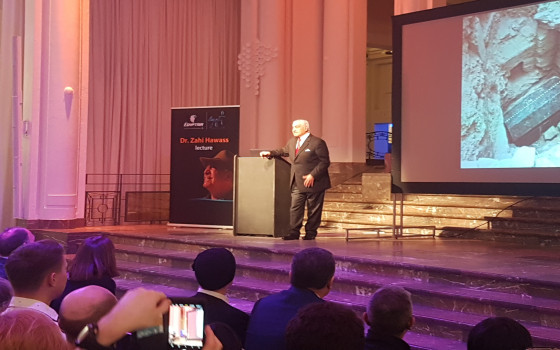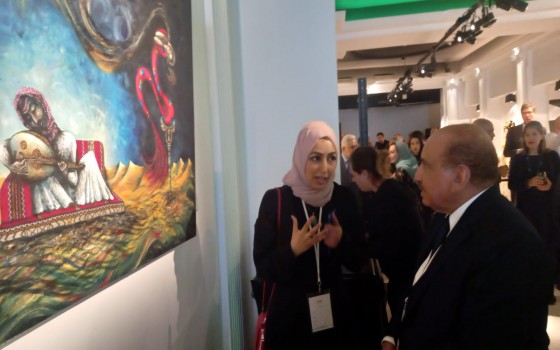
Zahi Hawass in Brussels to give a lecture on the sidelines of the Tutankhamun exhibition

- Europe and Arabs
- Saturday , 22 October 2022 13:41 PM GMT
Brussels: Europe and the Arabs
Egyptologist and former Minister of Antiquities Dr. Zahi Hawass will arrive in Brussels within the next few hours to give a lecture on the sidelines of the Tutankhamun exhibition, which is currently being held in the capital of Belgium and the European Union, and the lecture will be about the available information on “Tutankhamun” and the latest discoveries made in Valley of the Kings.
The exhibition is held under the title Tutankhamun: His Tomb and Treasures, an exhibition that offers guests an unprecedented look at ancient Egypt. With hundreds of stunning pieces and ornaments, and fascinating interpretations, the organizers said on their website, “It is the most complete exhibition in the world dedicated to revealing the life of the young king. Prepare to travel to the age of the pharaohs.”
The exhibition was inaugurated on July 20 and will continue until the end of December in one of the exhibition palaces near the St. Jose district in the capital, Brussels.
The exhibition "Tutankhamun, his tomb and his treasures" includes no less than a thousand pieces reconfigured and presented in decorations that allow visitors to see the stages of the discovery of Tutankhamun's tomb a century ago. British archaeologist Howard Carter discovered the tomb on November 26, 1922 in the Valley of the Kings. The exhibition is based on Carter's blogs, supplemented by color photographs by British Egyptian archaeologist Harry Burton. The copies on display are among the 5,000 original pieces meticulously reproduced by Mostafa El-Azzabi, one of Cairo's most famous sculptors.
This funerary treasure has been meticulously reproduced thanks to 3D technology, as the burial chambers reveal some of their secrets that have remained unknown throughout this long period of time. The copies preserved in Cairo were completed under the scientific supervision of Egyptian artists.
The pieces on display in an area of more than 3,000 square meters include a golden chariot, the sarcophagus, the king's jewels, his dagger, amulets and statues, not to mention the golden mask of "Tutankhamun", the young pharaoh who died more than three thousand years ago.
The exhibition, which opened in 2008 in Zurich, Switzerland, and travels throughout Europe, attempts to shed light on the strange fate of the most famous pharaoh of Egypt, who ascended the throne at the age of eight and died ten years after that date, due to several diseases, including malaria.
The exhibition was visited by seven and a half million people during its stay in 40 cities in the world.
It is noteworthy that the famous Tutankhamun exhibition, which was opened in the early eighties under the patronage of then Egyptian President Anwar Sadat and Karl Carstens, included fifty-five original pieces. In 1961, the Egyptian Museum in Cairo lent, for the first time, substantial antiquities abroad.
Tutankhamun is one of the pharaohs of the Eighteenth Egyptian Dynasty in the history of ancient Egypt, and he was the pharaoh of Egypt from 1334 BC to 1325 BC. Tutankhamun is one of the most famous pharaohs for reasons not related to the achievements he achieved or the wars he won, as is the case with many of the pharaohs; Rather, it is for other reasons that are historically important, most notably the discovery of his tomb and its treasures completely without any damage. In addition to the mystery surrounding the circumstances of his death, as many considered the death of Pharaoh at a very early age to be unnatural, especially with the presence of fractures in the femur and skull, and the marriage of his minister to his widow after his death and establishing himself as Pharaoh.
The heavy use of the myth of the curse of the pharaohs associated with the tomb of Tutankhamun, which was used in films and video games, made Tutankhamun the most famous pharaoh for puzzles and questions that are still unanswered, considered by some to be one of the oldest assassinations in human history. Tutankhamun died young and was buried in his tomb - Tomb 62 - in the Valley of the Kings.
Tutankhamun was nine years old when he became the pharaoh of Egypt and his name in ancient Egyptian means "the living image of the god Amun", the great ancient Egyptian deity. Tutankhamun lived in a transitional period in the history of ancient Egypt, where he came after Akhenaten, who tried to unite the gods of ancient Egypt in the form of the one God Sunday. During his reign, he returned to the worship of the various gods of ancient Egypt.












No Comments Found